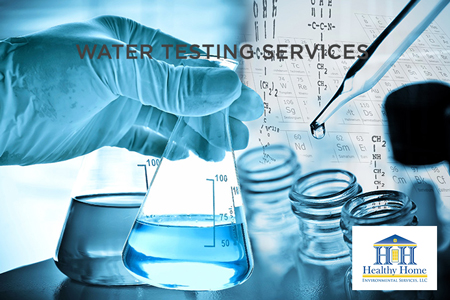Discover What Is Included in Water Checking and Exactly How It Makes Sure Safe Alcohol Consumption Water
Understanding the details of water screening is essential in guaranteeing the top quality and safety of our drinking water. Through a meticulous assessment of physical, chemical, and microbiological aspects, water testing identifies potential impurities that can posture wellness dangers.
Trick Parts of Water Testing
Water testing is an important procedure that involves a number of crucial parts to ensure the security and high quality of alcohol consumption water. One of the key elements is the assessment of physical qualities, consisting of smell, turbidity, and shade. These qualities can supply initial insights right into the water's problem and potential contamination sources. Furthermore, making sure the pH equilibrium of water is essential, as it affects the water's corrosiveness and the efficacy of disinfection procedures.
Another significant part entails microbiological analysis, where water samples are taken a look at for the existence of bacteria such as germs, infections, and protozoa. This analysis is essential to recognize biological hazards that can pose health dangers if consumed. Additionally, chemical analyses are conducted to find not natural and organic materials, such as hefty steels, nitrates, and chemicals, that may be existing in the water.

Finding Hazardous Pollutants
Detecting damaging pollutants in drinking water is an essential facet of guarding public health. Each kind of pollutant poses distinct health and wellness dangers, making their detection important to guarantee the water eaten by the public is risk-free.
Water testing for contaminants is normally carried out by regulatory companies and water utilities, utilizing a combination of area tasting and laboratory analysis. These analyses are made to discover both normally happening substances and anthropogenic pollutants that might have entered the water system through farming overflow, commercial discharge, or maturing framework. Normal tracking is crucial, as contamination levels can fluctuate due to environmental modifications, seasonal variations, or human activities.
The identification of hazardous pollutants notifies needed activities, such as water treatment interventions or public advisories, to reduce risks. Early detection is essential to avoid negative wellness results, ranging from intestinal health problems to long-lasting problems like cancer, consequently making certain the proceeded safety and security of alcohol consumption water.

Chemical Analysis Techniques
In the realm of ensuring safe drinking water, chemical analysis methods play a critical role in recognizing and measuring pollutants. These methods are essential for spotting a large array of chemical compounds, including hefty metals, pesticides, and commercial pollutants, which can present substantial health dangers. Techniques such as atomic absorption spectroscopy (AAS) and inductively paired plasma mass spectrometry (ICP-MS) are commonly used to measure trace degrees of steels like lead, mercury, and arsenic. These tools provide accurate quantification, promoting conformity with governing standards.
Gas chromatography-mass spectrometry (GC-MS) is an additional essential method, particularly for organic substances. It separates complicated blends and recognizes semi-volatile and unpredictable natural compounds, guaranteeing that pollutants like benzene and toluene are within risk-free limits. High-performance fluid chromatography (HPLC) is likewise used for non-volatile materials, consisting of specific chemicals and pharmaceuticals.
Ion chromatography is used to establish concentrations of cations and anions, such as nitrates and sulfates, which are crucial in assessing water high quality. These chemical evaluation methods collectively make certain that alcohol consumption water stays safe by spotting inconsistencies from developed pureness norms, thereby guarding public health. Ensuring accuracy and precision in these tests is vital to maintaining the honesty of water safety evaluations.
Microbiological Evaluating Methods
Accurate microbiological screening is vital for guarding public health by guaranteeing that drinking water is cost-free from dangerous pathogens. This procedure includes detecting and enumerating microbes such as bacteria, viruses, and protozoa that might link pollute water materials. Common virus consist of Escherichia coli, Giardia, and Cryptosporidium, each posturing considerable health threats.
Several techniques are employed in microbiological screening to identify these risks. The membrane purification strategy is frequently utilized, including water travelling through a filter that catches germs, which are after that cultured to establish their existence and concentration. Conversely, the multiple-tube fermentation method allows the quantification of coliform bacteria utilizing a collection of dilution and incubation actions.
Advancements in technology have actually presented molecular techniques such as polymerase domino effect (PCR), which allows for the rapid and extremely certain detection of microorganisms by amplifying their genetic material. Enzyme-linked immunosorbent assays (ELISA) likewise offer a method to spot microorganisms by determining details healthy proteins or antigens.
These varied approaches are necessary for detailed water quality analysis, ensuring that water therapy procedures are effective which circulation systems maintain security. By using these microbiological testing methods, prospective carcinogen can be identified and minimized immediately.

Relevance for Public Wellness
Guaranteeing the microbiological security of alcohol consumption water straight influences public health by preventing the spread of waterborne illness. Virus such as germs, viruses, and protozoa can cause health problems like cholera, dysentery, and stomach infections (Water Tesing Services Tampa). The implementation of extensive water screening methods is critical in determining and reducing these dangers, therefore securing communities from potential outbreaks
Normal water testing not just detects microbial contaminants yet additionally assesses chemical and physical parameters that can impact wellness. Too much degrees of nitrates or heavy steels such as lead can pose significant health dangers, specifically to vulnerable populations like babies and pregnant females. By recognizing these risks early, water screening enables timely interventions, guaranteeing the water supply continues to be within secure usage standards.
Furthermore, water testing plays an important duty in maintaining public self-confidence in municipal water supply. It offers transparency and accountability, assuring the general public that their health and wellness is a top priority. For plan makers and health officials, the data acquired from water screening informs decisions on facilities financial investments and public health and wellness methods, guaranteeing sources are guided where they are most needed. This way, water screening is essential in promoting a much healthier, more secure culture.
Conclusion
Water testing offers as a crucial system for ensuring the safety and security and top quality of drinking this post water through detailed analysis of its physical, chemical, and microbiological residential properties. By spotting dangerous impurities, such as hefty metals and chemicals, and utilizing innovative strategies like chromatography and spectrometry, water testing assists in the identification of prospective health threats. The execution of strenuous screening procedures is essential for keeping conformity with security requirements, eventually guarding public wellness and strengthening confidence in metropolitan water supply.

By determining these dangers early, water testing allows timely interventions, ensuring the water supply remains within safe usage criteria.
Water screening serves as a necessary device for guaranteeing the safety and high quality of this link alcohol consumption water with detailed examination of its physical, chemical, and microbiological properties.